Thanks LSTA
By Mary Bigelow
Posted on 2009-03-20

The Louisiana Science Teachers Association has a welcome booth here, with friendly faces and suggestions for sightseeing and learning more about this great city and state. And on the Exhibit floor there is a booth with information on next year’s conference in Philadelphia. Mark your calendars for March 18-21, 2010.

The Louisiana Science Teachers Association has a welcome booth here, with friendly faces and suggestions for sightseeing and learning more about this great city and state. And on the Exhibit floor there is a booth with information on next year’s conference in Philadelphia. Mark your calendars for March 18-21, 2010.
How is my substitute doing?
By Mary Bigelow
Posted on 2009-03-20


The "cool" Darwin and the intersection of western science and native knowledge
By Lynn Petrinjak
Posted on 2009-03-19
Presenter Mark Plotkin seemed to enjoy being back in his native New Orleans earlier today as he talked about native cultures, Western science, and finding ways to use one to enhance the other. He encouraged attendees to make evolution relevant to their students by talking about the “cool Darwin.” Instead of the common photo of an aged, bearded Darwin, Plotkin shared an image of the man from his youth. He noted kids could identify with Darwin, who rebelled against his father’s wish that he become a doctor to sail on the HMS Beagle. Encouraging student interest in science is particularly important, Plotkin maintained, since science will be instrumental in solving most (if not all) the problems we face. As he said, “We need more science and we need it now.”
Plotkin’s presentation focused on his work with native peoples in the Amazon. He has worked with shamen (and women). Using maps created by tribal members on Goggle Earth, Plotkin showed his audience how their presence helps preserve the forest from illegal loggers, drug traffickers, and other threats. He says native peoples are “the best hope for turning conservation dreams into reality.” It was a fascinating look at how people anywhere can benefit from and contribute to scientific knowledge, and how that knowledge can make a real and immediate impact.
Presenter Mark Plotkin seemed to enjoy being back in his native New Orleans earlier today as he talked about native cultures, Western science, and finding ways to use one to enhance the other. He encouraged attendees to make evolution relevant to their students by talking about the “cool Darwin.” Instead of the common photo of an aged, bearded Darwin, Plotkin shared an image of the man from his youth. He noted kids could identify with Darwin, who rebelled against his father’s wish that he become a doctor to sail on the HMS Beagle.
Dynamic Duo
By Mary Bigelow
Posted on 2009-03-19


When I saw that the Planetary Society was sponsoring a session with Bill Nye and Neil deGrasse Tyson, I assumed that each would take the podium for a while. But those of us in the audience were treated to these two as dynamic copresenters! Their sense of humor did not detract form the importance of their message: Why We Need to Study Earth from Space. Both of these scientists are strong advocates for quality science education that will “change the world” – an important message since the future scientists in America are in our classrooms right now. After their discussion (about which several in the audience wondered if a recording would be available), they took questions from the audience. They also wondered how many science teachers we could remember who made a diffference in our lives. Some could recall 4 or 5. How many can you name?


When I saw that the Planetary Society was sponsoring a session with Bill Nye and Neil deGrasse Tyson, I assumed that each would take the podium for a while. But those of us in the audience were treated to these two as dynamic copresenters!
Looking inside the student brain to enhance learning
By Debra Shapiro
Posted on 2009-03-19
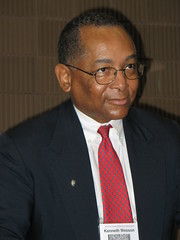
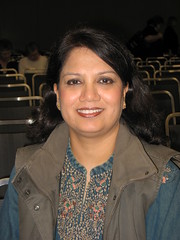
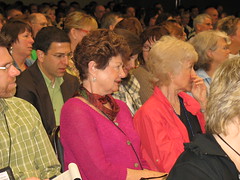
The audience was surprised to learn from Dr. Wesson that larger brains have been proven to be less efficient than smaller-sized brains.

Morning musings
By Mary Bigelow
Posted on 2009-03-19


Even in March the humidity here is high. Along with the morning fog, it makes for a place where “resistance is futile” in terms of coiffures!
Walking through the deserted streets this morning to catch the streetcar for an early session, I saw people walking their dogs, having coffee in a local shop, watering plants, and sweeping their sidewalks. And then I passed a magnificent red building – an elementary school in the French Quarter. The children were laughing, talking, and running in their uniforms of green, gold, or purple shirts. It occurred to me that even though the city is full of architectural delights, historic locations, and wonderful cuisine, the reason we’re all here is—the students.


Even in March the humidity here is high. Along with the morning fog, it makes for a place where “resistance is futile” in terms of coiffures!
Busy morning at the conference
By Lynn Petrinjak
Posted on 2009-03-19
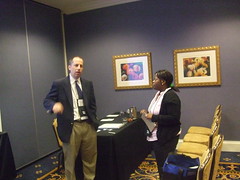
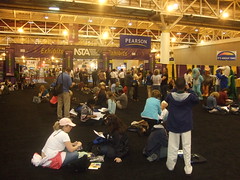

So many sessions, so little time
By Mary Bigelow
Posted on 2009-03-18
 I went over to the conference center this afternoon to pick up my badge holder, tote bag, and conference program. When I pulled out the program, my spouse remarked “That’s a big program.” His eyes got larger when I kept pulling volumes out of the bag. Four to be exact – one for each day and one just to list all of the vendors. Armed with a highlighter, I’m going to work on my schedule for tomorrow!
I went over to the conference center this afternoon to pick up my badge holder, tote bag, and conference program. When I pulled out the program, my spouse remarked “That’s a big program.” His eyes got larger when I kept pulling volumes out of the bag. Four to be exact – one for each day and one just to list all of the vendors. Armed with a highlighter, I’m going to work on my schedule for tomorrow! I went over to the conference center this afternoon to pick up my badge holder, tote bag, and conference program. When I pulled out the program, my spouse remarked “That’s a big program.” His eyes got larger when I kept pulling volumes out of the bag. Four to be exact – one for each day and one just to list all of the vendors. Armed with a highlighter, I’m going to work on my schedule for tomorrow!
I went over to the conference center this afternoon to pick up my badge holder, tote bag, and conference program. When I pulled out the program, my spouse remarked “That’s a big program.” His eyes got larger when I kept pulling volumes out of the bag. Four to be exact – one for each day and one just to list all of the vendors. Armed with a highlighter, I’m going to work on my schedule for tomorrow!How can we make time to teach science in preK-2 classrooms?
By Peggy Ashbrook
Posted on 2009-03-17
Observing the life cycle of an insect can include measuring growth and weight, counting calendar days and reading fiction, non-fiction, and writing poetry and descriptions—all ways to integrate science with other subjects in elementary school. Many skills and much information, such as, learning about the continents and names of land forms, how to read or make a map, learning what are natural resources, understanding weather vocabulary, how to describe parts of a whole, using pictures to check for meaning, using graphic organizers, re-telling a story or event using the beginning-middle-ending format, recognizing that letters are symbols for sounds, comparing story traditions of own and other cultures, asking and answering questions, using graphs, charts, and signs to acquire information, and using prior knowledge to predict meaning and make sense of texts are all skills that can be taught during science activities as well as during the reading, math, and social studies time periods.


Whew! Children learn so much in the early childhood school years and it all seems to connect.
What kinds of lesson plans do you teach which integrate science with social studies, math, and language arts?

Observing the life cycle of an insect can include measuring growth and weight, counting calendar days and reading fiction, non-fiction, and writing poetry and descriptions—all ways to integrate science with other subjects in elementary school.
Bits and pieces
By Mary Bigelow
Posted on 2009-03-14
Here are some items of interest:
- Teachers’ Domain announces a new new Adolescent Literacy Special Collection: Inspiring Middle School Literacy: Reading and Writing in Science and History. According to the information sent by WGBH, “These self-paced classroom activities are designed to enhance the literacy skills of struggling readers in grades 5-8. Each activity uses videos, interactive activities, notetaking, reading, and writing to present students with an engaging science or history topic. All 15 activities promote a range of literacy skills including monitoring comprehension, synthesizing, asking questions, developing vocabulary, connecting prior knowledge to new learning, and developing a topic in writing.” I’ve found that Teachers’ Domain is a wonderful resource for a variety of topics in science (and other content areas), and the science topics in this literacy collection include Continental Drift: From Idea to Theory, Exploring the Everglades Environment, Newton’s Third Law: Action-Reaction, Reproductive Strategies, Snake Jaws: A Lesson in Evolution, Surviving Winter, and Transitional Fossils.
- I’ve heard about a new documentary called Naturally Obsessed: The Making of a Scientist. According to the website, this film follows the research of a group of graduate students and addresses the reasons people become scientists and the challenges they face. I haven’t seen this yet, but I understand that it is showing at various film festivals.
It’s hard to get away for a conference. But here’s an offer you can’t refuse: Since I am a free agent, I can plan my own conference schedule. If you can’t make the conference, but there are hot topics you’d like to suggest, let me know and I’ll focus my energies on a few of them and report back through the conference blog site, with session summaries and resources. Just add your suggestions through a comment below!
Here are some items of interest:


